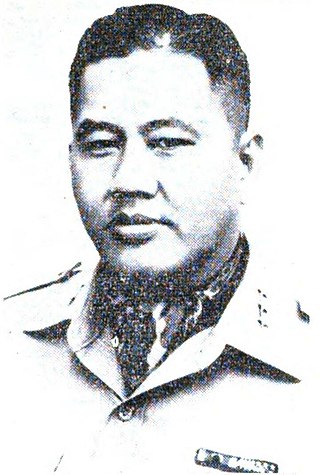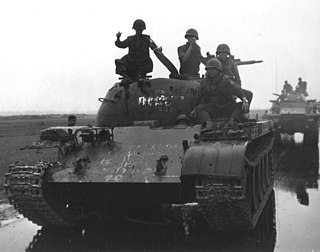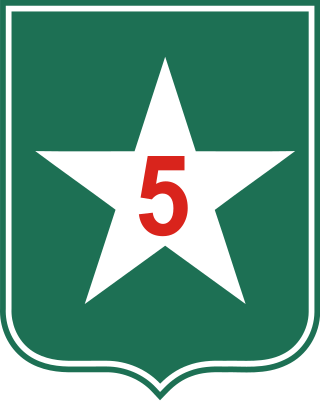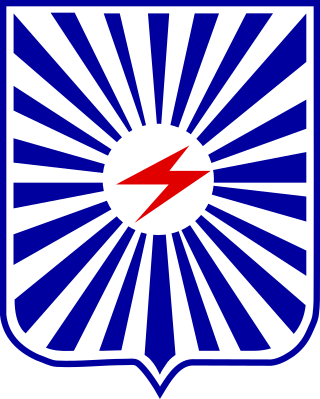
Dương Văn Minh, popularly known as Big Minh, was a South Vietnamese politician and a senior general in the Army of the Republic of Vietnam (ARVN) and a politician during the presidency of Ngô Đình Diệm. In 1963, he became chief of a military junta after leading a coup in which Diệm was assassinated. Minh lasted only three months before being toppled by Nguyễn Khánh, but assumed power again as the fourth and last President of South Vietnam in April 1975, two days before surrendering to North Vietnamese forces. He earned his nickname "Big Minh", because he was approximately 1.83 m (6 ft) tall and weighed 90 kg (198 lb).

Nguyễn Văn Thiệu was a South Vietnamese military officer and politician who was the president of South Vietnam from 1967 to 1975. He was a general in the Republic of Vietnam Armed Forces (RVNAF), became head of a military junta in 1965, and then president after winning a rigged election in 1967. He established rule over South Vietnam until he resigned and left the nation and relocated to Taipei a few days before the fall of Saigon and the ultimate North Vietnamese victory.

The Army of the Republic of Vietnam composed the ground forces of the South Vietnamese military from its inception in 1955 to the Fall of Saigon in April 1975. At the ARVN's peak, an estimated 1 in 9 citizens of South Vietnam were enlisted, composed of Regular Forces and the more voluntary Regional Forces and the Popular Force militias. It is estimated to have suffered 1,394,000 casualties during the Vietnam War.

The Easter Offensive, also known as the 1972 spring–summer offensive by North Vietnam, or the Red Fiery Summer as romanticized in South Vietnamese literature, was a military campaign conducted by the People's Army of Vietnam against the Army of the Republic of Vietnam and the United States military between 30 March and 22 October 1972, during the Vietnam War.

The 1975 spring offensive, officially known as the general offensive and uprising of spring 1975, was the final North Vietnamese campaign in the Vietnam War that led to the capitulation of Republic of Vietnam. After the initial success capturing Phước Long Province, the North Vietnamese leadership increased the scope of the People's Army of Vietnam's (PAVN) offensive and captured and held the key Central Highlands city of Buôn Ma Thuột between 10 and 18 March. These operations were intended to be preparatory to launching a general offensive in 1976.

The Battle of Ban Me Thuot was a decisive battle of the Vietnam War which led to the complete destruction of South Vietnam's II Corps Tactical Zone. The battle was part of a larger North Vietnamese military operation known as Campaign 275 to capture the Tay Nguyen region, known in the West as the Vietnamese Central Highlands.

Lê Văn Hưng was an infantry general of the Army of the Republic of Vietnam. Hưng was perhaps best known as the "Hero of An Lộc" in 1972 when he commanded the 5th Division in defense of the city of An Lộc from the coordinated attacks of the North Vietnamese People's Army of Vietnam (PAVN) forces in the Battle of An Lộc.

Lê Minh Đảo was a Major general in the South Vietnamese Army of the Republic of Vietnam (ARVN). He commanded the 18th Division nicknamed "The Super Men", at Xuân Lộc, the last major battle of the Vietnam War.

Ngô Du (1925–1977) was a Lieutenant general in the Army of the Republic of Vietnam (ARVN).

Nguyễn Văn Toàn was a Lieutenant general in the South Vietnamese Army of the Republic of Vietnam (ARVN).

Major General Phạm Văn Phú was an officer in the Army of the Republic of Vietnam.

Cao Văn Viên was a four-star army general in the Army of the Republic of Vietnam during the Vietnam War. He rose to the position of Chairman of the South Vietnamese Joint General Staff. Considered one of "the most gifted" of South Vietnam's military leaders, he was previously called an "absolute key figure" and one of "the most important Vietnamese military leaders" in the U.S.-led fighting during the Vietnam War. Along with Trần Thiện Khiêm he was one of only two four-star generals in the entire history of South Vietnam.

Đỗ Mậu was a Major general in the South Vietnamese Army of the Republic of Vietnam (ARVN), best known for his roles as a recruiting strategist in both the 1963 coup that toppled President Ngô Đình Diệm and the 1964 coup led by General Nguyễn Khánh that deposed the junta of General Dương Văn Minh. He was born in Quảng Bình Province.

I Corps was a corps of the Army of the Republic of Vietnam (ARVN), the army of the nation state of South Vietnam that existed from 1955 to 1975. It was one of four corps of the ARVN. This was the northernmost region of South Vietnam, bordering North Vietnam at the Vietnamese Demilitarized Zone (DMZ). These five provinces are Quảng Trị Province,, Thừa Thiên-Huế Province,, Quảng Nam Province,, Quảng Tín Province, and Quảng Ngãi Province,.

The Fifth Division of the Army of the Republic of Vietnam (ARVN)—the army of the nation state of South Vietnam that existed from 1955 to 1975—was part of the III Corps that oversaw the region of the country surrounding the capital, Saigon.

The 21st Division of the Army of the Republic of Vietnam (ARVN)—the army of the nation state of South Vietnam that existed from 1959 to 1975, was part of the IV Corps that oversaw the southernmost region of South Vietnam, the Mekong Delta. The 21st Division was based in Chương Thiện province, the southernmost province in the whole country, in an area dominated by jungles and swamps.
Nguyễn Vĩnh Nghi was a Lieutenant general in the South Vietnamese Army of the Republic of Vietnam (ARVN).

The Hue–Da Nang Campaign was a series of military actions conducted by the People's Army of Vietnam (PAVN) against the Army of the Republic of Vietnam (ARVN) during the Vietnam War, also known in Vietnam as the American War. The campaign was centred on the cities of Huế and Da Nang, with secondary fronts in the provinces of Quảng Trị and Quảng Ngãi. The campaign began on March 5 and concluded on April 2, 1975.

Nguyễn Hữu Hạnh was a Vietnamese military officer of South Vietnam during the Vietnam War, rising to the rank of Brigadier General.


















